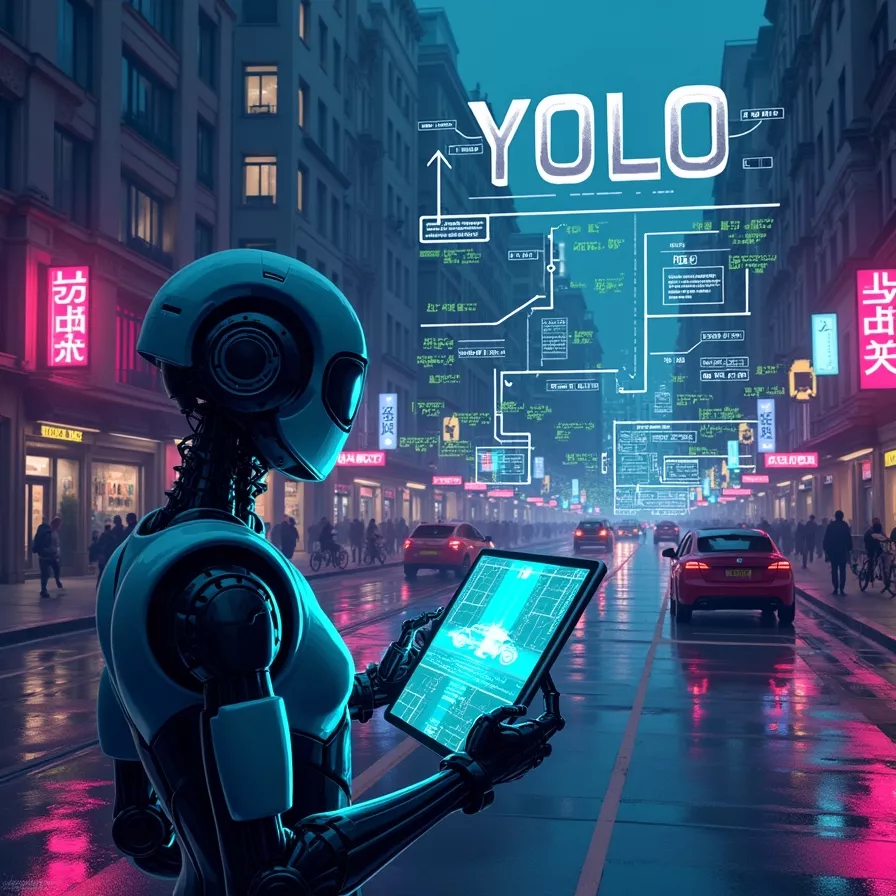YOLO Object Detection Guide: Mastering Real-Time Detection in 2025
Introduction
Picture a security camera that can spot a suspicious item right away or a self-driving car that recognizes pedestrians in no time at all. That’s the magic of YOLO, which stands for You Only Look Once. This cool real-time object detection model has been changing the game in computer vision since it first came out in 2015, thanks to Joseph Redmon. YOLO has grown through versions like YOLOv8 and YOLOv9, giving amazing speed and accuracy for things like driverless cars, security systems, and retail tracking. Since it’s open-source, anyone can dive in, from hobbyists to pro developers, using YOLO to identify objects in pictures or videos. It’s truly a vital part of modern AI.
This detailed guide on Temploop is your go-to source for all things YOLO in 2025. Whether you’re just starting out with AI or you’re a developer creating cutting-edge apps, we’ll cover what you need to know about YOLO: its basics, how it works, the different versions, real-world uses, and easy setup steps. With handy tips and examples, this guide makes it easy to grasp YOLO while also tackling hurdles like hardware needs. Let’s jump into real-time object detection and discover what YOLO can do!
What is YOLO?
YOLO, or You Only Look Once, is an impressive object detection model recognized for its speed and accuracy. Instead of scanning images multiple times like traditional methods, YOLO takes a whole image in one go, figuring out bounding boxes and class probabilities all at once. Launched in 2015 by Joseph Redmon, YOLO has really shaken up computer vision, allowing for real-time detection of up to 45 frames per second.
Key Features
- Speed : It processes images in milliseconds, making it perfect for quick applications like video analysis.
- Accuracy : YOLO boasts a high mean Average Precision (mAP), with YOLOv8 hitting 50.2% on COCO datasets.
- Simplicity : It combines localization and classification in a single network, which cuts down on complexity.
- Open-Source : You can find it on GitHub, allowing for easy customization.
For instance, a retail shop could use YOLO to spot empty shelves right away, alerting the staff in a flash. Its ability to recognize all kinds of items, like cars or animals, makes it super versatile for various industries.
How Does YOLO Work?
The magic of YOLO is in its single-pass design. Here’s a straightforward breakdown:
- Image Division : YOLO splits an image into a grid (like 7x7 in earlier versions).
- Bounding Box Prediction : Each grid cell predicts a bunch of bounding boxes along with confidence scores.
- Class Probabilities : It assigns probabilities for different object classes (like "dog" or "car") within each box.
- Non-Max Suppression : It filters out overlapping boxes to pick the most accurate detections.
This approach allows YOLO to quickly identify objects while still keeping accuracy. Take a traffic video, for example, where YOLO can detect cars and pedestrians in mere milliseconds, helping in real-time decisions.
Evolution of YOLO Versions
YOLO has really changed since it first launched. Let's look at some key versions:
- YOLOv1 (2015) : The first version introduced the single-pass method, working at 45 FPS but with lower accuracy.
- YOLOv3 (2018) : This version improved accuracy with multi-scale predictions, scoring 57.9% mAP on COCO.
- YOLOv8 (2023) : This version boosted speed and accuracy with a score of 50.2% mAP and included image segmentation support.
- YOLOv9 (2024) : Added cool features like Programmable Gradient Information (PGI) for better training, improving stability.
Each version builds on the previous one, striking a balance between speed and precision. YOLOv8 is particularly great for mobile devices, while YOLOv9 is perfect for tougher tasks like medical imaging.
Real-World Applications of YOLO
YOLO’s versatility has made it popular across many industries. Here are some notable uses:
- Autonomous Driving : Recognizes cars, pedestrians, and signs in real-time, just like Tesla does.
- Surveillance : Spots possible threats in security footage, helping keep public areas safer.
- Retail : Keeps track of stock levels, identifying empty shelves or misplaced items, as seen in Walmart’s systems.
- Healthcare : Analyzes medical images for things like tumors in X-rays.
- Sports Analytics : Tracks players and objects in real-time, used in systems like Hawk-Eye.
For example, a smart city could implement YOLO to manage traffic flow, quickly spotting congestion to optimize traffic signals.
How to Implement YOLO in Python
Excited to give YOLO a shot? Here’s a simple guide to get you started using Python and PyTorch:
Prerequisites
- Hardware : A GPU (like an NVIDIA RTX 3060) is ideal for faster training, but CPUs can work for smaller tasks.
- Software : Make sure you have Python 3.8 or later, along with PyTorch and OpenCV installed.
- Dataset : You’ll need a labeled dataset (like COCO format) for training.
Step-by-Step Setup
- Install Dependencies : Run
pip install torch torchvision opencv-python ultralyticsto get the libraries you need. - Download Pre-Trained Model : Grab YOLOv8 from Ultralytics with
pip install ultralytics. - Prepare Dataset : Use tools like LabelImg to mark images with bounding boxes.
- Train the Model : Execute
yolo train model=yolov8n.pt data=your_dataset.yaml epochs=50to start training. - Test the Model : Run
yolo predict model=best.pt source=your_image.jpgto check out object detection on new images.
For example, you might train YOLO to find cats in pictures by marking up 100 images and running the training script, seeing results in just a few hours.
Best Practices for Training YOLO Models
To get top-notch results, keep these tips in mind:
- Data Quality : Use a variety of high-quality images to prevent bias.
- Augmentation : Apply methods like rotation or flipping to boost the model’s toughness.
- Hyperparameter Tuning : Adjust things like learning rates (try 0.001) and batch sizes (like 16) for best performance.
- Hardware Optimization : Go for GPUs to speed up training since CPUs might take days with large datasets.
Starting with pre-trained models can save time and improve accuracy too.
YOLO vs Other Object Detection Models
How does YOLO stack up against models like Faster R-CNN or SSD?
| Model | Speed (FPS) | mAP (COCO) | Best For |
|---|---|---|---|
| YOLOv8 | 80-100 | 50.2% | Real-time applications |
| Faster R-CNN | 5-15 | 55.0% | High-accuracy tasks |
| SSD | 20-40 | 45.0% | Balanced speed and accuracy |
| EfficientDet | 10-30 | 52.0% | Resource-constrained devices |
YOLO shines in speed, making it perfect for real-time tasks, while Faster R-CNN may offer a bit more accuracy for static analyses.
Challenges and Limitations
Even though YOLO is powerful, it has its challenges:
- Hardware Needs : It requires GPUs for efficient training, which can limit access.
- Data Dependency : Needs a lot of labeled data to reach high accuracy.
- Small Object Detection : It can struggle with small items, like faraway pedestrians.
- Complexity : Setting things up and tuning can feel overwhelming for newbies.
You can tackle these issues by using cloud GPUs, pre-trained models, and data augmentation.
Future of YOLO in 2025
The future of YOLO is full of promise with trends like:
- Improved Models : YOLOv10 and beyond might enhance detection of small items and overall efficiency.
- Edge Computing : More optimized versions for mobile and IoT devices.
- Broader Applications : More use in areas like robotics, farming, and augmented reality.
These advancements will make YOLO even easier to use and influential.
Frequently Asked Questions (FAQs)
- What is YOLO object detection?
YOLO (You Only Look Once) is a real-time model that identifies objects in images or videos quickly and accurately. - How does YOLO differ from other models?
YOLO works in one go, which is much faster than models like Faster R-CNN that involve several steps. - Can beginners use YOLO?
Absolutely! With tools like Ultralytics and Python, even beginners can start with pre-trained models and simple guides. - What are the best YOLO versions for 2025?
YOLOv8 and YOLOv9 strike a good balance of speed and accuracy, making them great for most uses. - How fast is YOLO?
YOLOv8 can handle 80-100 FPS on modern GPUs, allowing for real-time detection. - What are YOLO’s real-world applications?
Used across driving, surveillance, retail, healthcare, and sports analytics. - Do I need a GPU to use YOLO?
A GPU is best for training, but you can use CPUs for smaller tasks or inference. - How do I train a YOLO model?
Use Python, PyTorch, and a labeled dataset, following simple tutorials from Ultralytics. - Can YOLO detect small objects?
It faces challenges with tiny objects but gets better with newer versions and with data augmentation techniques. - Is YOLO open-source?
Yes, it’s available on GitHub, with support from frameworks like Darknet and Ultralytics.
Conclusion
YOLO is changing the game for real-time object detection, offering speed and accuracy for uses from self-driving cars to retail tracking. This guide has given you the basics to understand, set up, and fine-tune YOLO, whether you’re a newbie or an experienced developer. Start exploring YOLO today through the resources available and get ahead in the world of AI. Dive into the exciting future of computer vision and make YOLO work for you!










